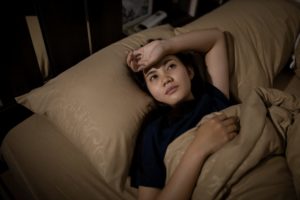Fatal Insomnia
Fatal insomnia is a rare disorder marked by trouble sleeping, cognitive issues, and other symptoms that become progressively worse over time. Although insomnia — defined as trouble falling or staying asleep — is a symptom of fatal insomnia, the two should not be confused. Up to half of all people experience insomnia at some point and, although it is damaging to one’s health, it is not normally fatal. Fatal insomnia is extremely rare and, with time, causes death.
We discuss symptoms, causes, diagnostic criteria, and treatment options for the two types of fatal insomnia: fatal familial insomnia and sporadic fatal insomnia.
What Is Fatal Insomnia?
Despite its name, fatal insomnia is not considered a sleep disorder. Instead, fatal insomnia is a degenerative nerve disease known for causing sleep troubles and other symptoms that become progressively worse. Specifically, fatal insomnia is a prion disease.
Prion diseases involve an abnormality in a type of protein found in the human body called a prion. In prion diseases, prion proteins are misfolded, with the ability to transfer this defect to surrounding prions. With fatal insomnia, these faulty prions accumulate in a part of the brain called the thalamus, which is involved in regulating sleep . The accumulation of prions and resulting damage to the neurons cause symptoms associated with brain and nervous system damage and, ultimately, death. Prion diseases are very uncommon, only occurring in 1 to 1.5 people per million each year.
There are two types of fatal insomnia: fatal familial insomnia and sporadic fatal insomnia. Their causes, symptoms, and projected outcomes overlap but vary slightly.
Is Your Sleep a Problem?
Answer three questions to understand if you should be concerned.
Fatal Familial Insomnia
In fatal familial insomnia (FFI), a genetic mutation of the prion protein (PRNP) gene causes abnormalities in prion proteins. As a result, the disorder is hereditary, meaning it runs in families. A child with one parent who carries the genetic mutation has a 50% chance of inheriting the mutation themselves .
Fatal familial insomnia is extremely rare, with only an estimated 70 families around the world carrying this genetic mutation.
Sporadic Fatal Insomnia
Sporadic fatal insomnia (SFI or sFI) occurs when a person experiences prion protein abnormalities associated with fatal familial insomnia, even though they lack the genetic mutation found in people with that disorder. Experts believe normal prion proteins randomly develop abnormalities in people who have sporadic fatal insomnia, for reasons that are not yet known. Some researchers categorize sporadic fatal insomnia as a subtype of another prion disease, called sporadic Jakob-Cruetzfeldt disease.
Sporadic fatal insomnia is even rarer than fatal familial insomnia. Only 25 people have been identified as having the disease as of 2018.

Symptoms
Symptoms of fatal insomnia vary somewhat depending on if a person has fatal familial insomnia or sporadic fatal insomnia.
In fatal familial insomnia, trouble sleeping and vivid dreams are often the first noticeable symptoms. Fatal familial insomnia often causes the following additional symptoms over time as the disease progresses:
- Rapid heartbeat and breathing
- Excessive sweating
- High blood pressure
- Memory and attention problems
- Trouble maintaining balance
- Trouble regulating body temperature
- Mood changes
- Weight loss
- Double vision
- Trouble swallowing
- Difficulty speaking
Trouble sleeping is also a symptom of sporadic fatal insomnia, but it is usually not the first symptom people notice. Instead, people with sporadic fatal insomnia may experience cognitive problems or problems with speech and balance as early indicators of the disease. Case studies name attention and memory issues in one person and slurred talking, mood changes, and double vision in another as early symptoms. However, even though a person in the early stages of sporadic fatal insomnia might not report sleep problems, performing a sleep study is likely to reveal abnormalities.
Stages of Fatal Insomnia
Fatal familial insomnia usually progresses through multiple stages, beginning with insomnia symptoms that worsen. As the name implies, fatal insomnia ends in death. The entire process from first symptom onset to death lasts about 18 months on average, though in some people, it can last as little as 7 months or as long as 73 months. Sporadic fatal insomnia tends to last longer, with an average duration of 30 months from first symptoms to death.
Experts have outlined four distinct stages of fatal familial insomnia. Some researchers say those with sporadic fatal insomnia experience these stages identically, but others suggest symptoms present differently. With sporadic fatal insomnia occurring so rarely, more research is likely needed to better understand similarities and differences in how the two disorders progress.
The stages of fatal familial insomnia are as follows:
- Stage One (Lasts 3 to 6 Months): Insomnia appears and becomes worse over time. Vivid dreams might occur during sleep. Psychological symptoms, such as panic attacks and paranoia, might begin.
- Stage Two (Lasts 5 to 9 Months): Mood changes appear or worsen, and anxiety or depression might set in. Nervous system dysfunction begins, marked by increased heart rate, blood pressure, temperature, sweating, breathing, and stress hormones. Trouble moving or changes in walking might occur.
- Stage Three (Lasts 3 Months): The sleep cycle is severely disrupted. Sleeping is very difficult.
- Stage Four (Lasts up to 6 Months): The inability to sleep causes dementia, trouble speaking, and eventually, a coma followed by death.
Several variations of the genetic mutation causing fatal familial insomnia exist. The disease typically progresses faster for people who have what is called the homozygous Met-Met variant.
Causes and Trends
Symptoms of fatal insomnia are caused by misfolded prion proteins that accumulate in the brain, particularly the thalamus, and kill neurons. In the case of fatal familial insomnia, a genetic mutation causes the illness. With sporadic fatal insomnia, the cause is unknown.
Beyond genetics, risk factors for fatal insomnia have not yet been identified. Researchers have noticed some trends, however, in terms of the age at which people tend to begin showing symptoms, and where people with this disease live.
Genetics
A mutation in the prion protein (PRNP) gene causes fatal familial insomnia. Usually, this genetic mutation is inherited from a parent. Rarely, someone may develop a genetic prion disease despite neither of their parents carrying the gene. Fatal familial insomnia occurs equally across sexes.
In contrast to familial fatal insomnia, sporadic fatal insomnia occurs randomly and is not associated with a genetic mutation.
Age
Fatal insomnia symptoms tend to develop in middle age. Fatal familial insomnia begins at an average age of 50, though cases have been recorded in people as young as 21 and as old as their early 70s. On average, sporadic fatal insomnia symptoms begin at 43 years of age, though they have been documented in people as young as 13 years old.
Nationality
Fatal insomnia has been found in people around the world, but has so far appeared more commonly in European countries, particularly Italy, Spain, and Germany. The disease continues to be more prevalent in Italy and Germany today, and both Italian and German families that have the genetic mutation have participated in research studies of potential treatments . Recent research suggests Chinese people of Han descent might also be more prone to the disease.
Diagnosis of Fatal Insomnia
Fatal insomnia can be difficult to identify based on the symptoms alone, especially for people who have no record of a family member with the disease . However, multiple researchers have outlined potential clinical diagnostic criteria for fatal familial insomnia. To be diagnosed, a person must complain of sleep problems or show sleep disturbances on a sleep study. According to one set of criteria, they must also have at least two of the following types of symptoms associated with brain degeneration:
- Psychiatric symptoms, such as hallucinations, depression, anxiety, or changes in personality
- Trouble controlling bodily movements
- Problems with seeing, such as blurred or double vision
- Uncontrollable muscle twitching
- Cognitive or memory problems
The person must also experience one of the following: weight loss, changes in voice, or vegetative symptoms like excessive sweating, rapid heart rate, and trouble regulating body temperature. People whose symptoms match this profile are considered potential candidates for having fatal familial insomnia.
Initially, healthcare professionals generally conduct a blood test to eliminate other possible causes of symptoms, like vitamin deficiencies and thyroid problems. Then, to diagnose fatal insomnia, doctors may proceed to conduct genetic testing, a sleep study (polysomnography), brain scans, or an analysis of cerebrospinal fluid.
Diagnosing sporadic fatal insomnia involves considering similar symptoms and conducting many of the same tests used to diagnose fatal familial insomnia.
Genetic Testing
When a person exhibits clinical symptoms of fatal insomnia, a doctor might order genetic testing . If a genetic test uncovers a mutation in the PRNP gene, that definitively verifies the diagnosis of fatal familial insomnia. In instances of sporadic fatal insomnia, there is no gene mutation, so this test does not apply.
Genetic testing also provides information about the type of genetic mutation a person has. There are two variations of the genetic mutation that causes fatal familial insomnia. The homozygous Met-Met variation usually leads to a shorter illness duration than the heterozygous variation.
Sleep Study
Medical professionals conduct a sleep study, called polysomnography, when they suspect fatal insomnia. People with this disorder often sleep for shorter periods of time, display little to no deep sleep, have shorter periods of rapid eye movement (REM) sleep, and experience vivid dreams. The polysomnography generally also reveals a drastic decline in sleep spindles and K-complexes, which are common brain activity patterns usually found during sleep. Polysomnography can be especially useful for people with sporadic fatal insomnia, who might not realize their sleep is affected.
Brain Scans
Doctors conduct brain scans to find abnormalities and brain damage in people with fatal insomnia. Most notably, positron emission tomography (PET) and single-photon emission tomography (SPECT) scans might show decreased activity in the thalamus region of the brain, which is the area most affected by fatal insomnia. Magnetic resonance imaging (MRI) might also show atrophy in certain regions of the brain.
Cerebrospinal Fluid Analysis
Sometimes, a detailed analysis of cerebrospinal fluid reveals abnormalities in people with fatal familial insomnia and sporadic fatal insomnia. Certain commonly analyzed features of cerebrospinal fluid remain normal, however.
Treatment Options for Fatal Insomnia
Experts have not yet found treatments that can cure fatal insomnia. Currently, treatments are considered palliative care, which means they are focused on providing relief to people experiencing this disease as they live out their final months of life.
Palliative Care
The type of palliative care given to people with fatal insomnia varies depending on each individual’s symptoms. Treatments for fatal familial insomnia and sporadic fatal insomnia are similar and overlapping. People with these disorders might try:
- Vitamin Supplementation: Taking vitamins B6, B12, iron, and folic acid has been shown to improve wellness in people experiencing sporadic fatal insomnia.
- A Healthy Diet: Doctors might recommend prioritizing eating nutritious foods to obtain beneficial vitamins. Also, dairy products, which contain tryptophan, may help promote sleep.
- Melatonin Supplementation: Levels of melatonin, a sleep hormone, fall in people with fatal insomnia. Taking melatonin supplementation might help promote sleep.
- Stopping Certain Medications: Under the guidance of their doctor, people with fatal insomnia may need to transition away from using any medications that might lead to increased memory loss, confusion, or insomnia.
- Sedative Use: Studies on sedatives for fatal insomnia have produced mixed results. Some people with fatal insomnia have experienced short-term relief by taking certain sedatives together with anti-anxiety drugs, while other research shows sedatives have no effect.
- Gamma-Hydroxybutyrate (GHB) Use: In one study, the drug GHB prompted slow-wave sleep in people with fatal familial insomnia.
- Antipsychotic Use: Some people with sporadic fatal insomnia report being able to sleep after taking phenothiazines, a class of antipsychotic medications.
- Therapy: Speaking with a therapist can help those with a fatal insomnia diagnosis, as well as their families and loved ones, process emotions related to the disease.
Future Research
In recent years, researchers have studied potential treatments for fatal insomnia and these studies will likely continue. Doxycycline, an antibiotic that affects prion proteins, is of particular interest for its apparent potential to delay the start of fatal insomnia symptoms. Researchers are also interested in how different types of vaccines could potentially prevent prion diseases.
When to See a Doctor
You should see a doctor if you are experiencing sleep problems or daytime sleepiness that interfere with your daily life. However, it is important to remember that while insomnia is very common, fatal insomnia is not.
Fatal insomnia presents similarly to many other disorders, such as dementia and Alzheimer’s disease. If you experience persistent insomnia symptoms accompanied by psychiatric, cognitive, or motor problems, make an appointment with your primary care physician to rule out other illnesses.

Still have questions? Ask our community!
Join our Sleep Care Community — a trusted hub of sleep health professionals, product specialists, and people just like you. Whether you need expert sleep advice for your insomnia or you’re searching for the perfect mattress, we’ve got you covered. Get personalized guidance from the experts who know sleep best.
Medical Disclaimer: The content on this page should not be taken as medical advice or used as a recommendation for any specific treatment or medication. Always consult your doctor before taking a new medication or changing your current treatment.
References
13 Sources
-
Geschwind, M. D. (2015). Prion diseases. Continuum (Minneapolis, Minn), 21(6 Neuroinfectious Disease), 1612–1638.
https://pubmed.ncbi.nlm.nih.gov/26633779/ -
Lindsley, C. W. (2017). Genetic and rare disease of the CNS. Part 1: Fatal familial insomnia (FFI). ACS Chemical Neuroscience, 8(12), 2570–2572., Retrieved August 30, 2021, from
https://pubmed.ncbi.nlm.nih.gov/29258312/ -
Zerr, I., Schmitz, M., Adam, M. P., Ardinger, H. H., Pagon, R. A., Wallace, S. E., Bean, L. J., Mirzaa, G., Amemiya, A., editors. (2021, January 7). Genetic prion disease. GeneReviews [Internet]., Retrieved August 30, 2021, from
https://pubmed.ncbi.nlm.nih.gov/20301407/ -
Cracco, L., Appleby, B. S., & Gambetti, P. (2018). Fatal familial insomnia and sporadic fatal insomnia. Handbook of Clinical Neurology, 153, 271–299.
https://pubmed.ncbi.nlm.nih.gov/29887141/ -
Blase, J. L., Cracco, L., Schonberger, L. B., Maddox, R. A., Cohen, Y., Cali, I., & Belay, E. D. (2014). Sporadic fatal insomnia in an adolescent. Pediatrics, 133(3), e766–e770.
https://pubmed.ncbi.nlm.nih.gov/24488737/ -
Moody, K. M., Schonberger, L. B., Maddox, R. A., Zou, W.-Q., Cracco, L., & Ignazio, C. (2011). Sporadic fatal insomnia in a young woman: A diagnostic challenge: Case report. BMC Neurology, 11, 136.
https://pubmed.ncbi.nlm.nih.gov/22040318/ -
Wu, L.-Y., Zhan, S.-Q., Huang, Z.-Y., Zhang, B., Wang, T., Liu, C.-F., Lu, H., Dong, X.-P., Wu, Z.-Y., Zhang, J.-W., Zhao, Z.-X., Han, F., Huang, Y., Lu, J., Gauthier, S., Jia, J.-P., & Wang, Y.-P. (2018). Expert consensus on clinical diagnostic criteria for fatal familial insomnia. Chinese Medical Journal, 131(13), 1613–1617.
https://pubmed.ncbi.nlm.nih.gov/29941716/ -
Abu-Rumeileh, S., Redaelli, V., Baiardi, S., Mackenzie, G., Windl, O., Ritchie, D. L., Didato, G., Hernandez-Vara, J., Rossi, M., Capellari, S., Imperiale, D., Rizzone, M. G., Belotti, A., Sorbi, S., Rozemuller, A. J., Cortelli, P., Gelpi, E., Will, R. G., Zerr, I., … & Parchi, P. (2018). Sporadic fatal insomnia in Europe: Phenotypic features and diagnostic challenges. Annals of Neurology, 84(3), 347–360.
https://pubmed.ncbi.nlm.nih.gov/30048013/ -
Forloni, G., Tettamanti, M., Lucca, U., Albanese, Y., Quaglio, E., Chiesa, R., Erbetta, A., Villani, F., Redaelli, V., Tagliavini, F., Artuso, V., & Roiter, I. (2015). Preventive study in subjects at risk of fatal familial insomnia: Innovative approach to rare diseases. Prion, 9(2), 75–79.
https://pubmed.ncbi.nlm.nih.gov/25996399/ -
Krasnianski, A., Juan, P. S., Ponto, C., Bartl, M., Heinemann, U., Varges, D., Schulz-Schaeffer, W. J., Kretzshmar, H. A., & Zerr, I. (2014). A proposal of new diagnostic pathway for fatal familial insomnia. Journal of Neurology, Neurosurgery, and Psychiatry, 85(6), 654–659.
https://pubmed.ncbi.nlm.nih.gov/24249784/ -
MedlinePlus: National Library of Medicine (US). (2021, August 2). Genetic testing. MedlinePlus., Retrieved August 30, 2021, from
https://medlineplus.gov/genetictesting.html -
Damavandi, P. T., Dove, M. T., & Pickersgill, R. W. (2017). A review of drug therapy for sporadic fatal insomnia. Prion, 11(5), 293–299.
https://pubmed.ncbi.nlm.nih.gov/28976233/ -
Burchell, J. T., & Panegyres, P. K. (2016). Prion diseases: Immunotargets and therapy. ImmunoTargets and Therapy, 5, 57–68.
https://pubmed.ncbi.nlm.nih.gov/27529062/






















